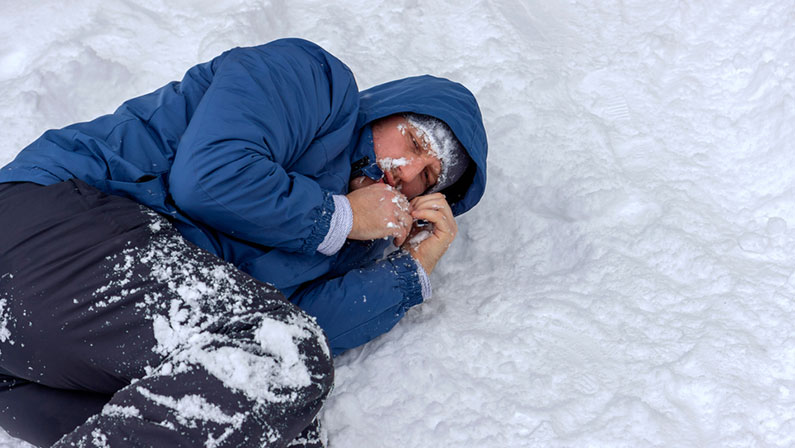In our daily lives, we often encounter various temperature extremes that can significantly impact our health. Among the most critical conditions related to temperature extremes are hypothermia and hyperthermia. Understanding these conditions is crucial for ensuring our well-being and responding effectively in emergency situations.
Hypothermia and hyperthermia are polar opposites, yet both can pose severe health risks if not addressed promptly. This article will explore the difference between hypothermia and hyperthermia, exploring their causes, symptoms, and preventive measures to help you stay safe regardless of the weather.
The Importance of Understanding the Difference Between Hypothermia and Hyperthermia

“What is the difference between hypothermia and hyperthermia?” Knowing the difference between hypothermia and hyperthermia can be life-saving. These conditions, though caused by opposite temperature extremes, require specific responses to ensure the safety and well-being of the affected individual. Proper knowledge can help in timely identification and treatment, potentially preventing severe complications or even fatalities.
What is Hypothermia?
Hypothermia occurs when the body loses heat faster than it can produce it, leading to a dangerously low body temperature. This condition typically arises in cold environments but can also result from exposure to cold water or prolonged periods in wet, windy conditions.
Causes of Hypothermia
Hypothermia can occur under various circumstances, primarily involving prolonged exposure to cold environments. Here are the usual causes:
- Prolonged Exposure to Cold Weather: Spending extended periods outdoors in freezing or near-freezing temperatures without adequate protection can lead to hypothermia. This is common among outdoor enthusiasts, homeless individuals, and people working in cold environments.
- Immersion in Cold Water: Falling into or swimming in cold water can rapidly lower body temperature, even if the air temperature is not extremely low. Water conducts heat away from the body much faster than air, increasing the risk of hypothermia significantly.
- Inadequate Clothing in Cold Environments: Wearing clothing that is insufficient for the weather conditions, such as not layering properly or failing to wear a hat and gloves, can contribute to heat loss. Clothing that is not windproof or waterproof can also lead to rapid cooling of the body.
- Wet and Windy Conditions: Wet clothing or skin significantly increases heat loss, as moisture conducts heat away from the body. Wind accelerates this process through the wind chill effect, where moving air strips away the layer of warm air surrounding the body, causing a faster drop in body temperature.
- Exhaustion or Dehydration: Physical exhaustion can impair the body’s ability to generate heat through muscle activity, while dehydration affects blood flow and the body’s ability to maintain a stable internal temperature. Both conditions make individuals more susceptible to the effects of cold weather, increasing the risk of hypothermia.
Stages of Hypothermia
Hypothermia progresses through several stages, each with increasingly severe symptoms:
- Mild Hypothermia: Shivering, dizziness, and confusion
- Moderate Hypothermia: Shivering stops, confusion increases, and motor skills decline
- Severe Hypothermia: Loss of consciousness, weak pulse, and shallow breathing
Hypothermia Symptoms
Recognizing the symptoms of hypothermia is crucial for early intervention and treatment. Symptoms range from mild signs like shivering and confusion to severe indicators such as loss of consciousness and a weak pulse.
- Intense shivering
- Slurred speech or mumbling
- Slow, shallow breathing
- Weak pulse
- Clumsiness or lack of coordination
- Drowsiness or very low energy
- Confusion or memory loss
Potential Complications of Hypothermia
Hypothermia can lead to a range of serious complications if not treated promptly and effectively. Here are the detailed potential complications:
- Frostbite: Frostbite occurs when the skin and underlying tissues freeze due to prolonged exposure to cold temperatures. It often affects extremities such as fingers, toes, ears, and nose. Frostbite can cause permanent damage to the affected areas, leading to numbness, infection, and even amputation in severe cases.
- Chilblains: Chilblains are small, itchy, red areas on the skin that develop after exposure to cold, damp conditions. They occur when the skin rewarms too quickly, causing blood vessels to expand faster than nearby smaller blood vessels can handle. This condition can result in swelling, blistering, and long-term skin damage.
- Trench Foot: Trench foot, also known as immersion foot, is a condition caused by prolonged exposure to wet and cold environments. It leads to numbness, swelling, and blisters, which can become infected if not treated. Severe cases may result in tissue loss and necessitate amputation.
- Permanent Tissue Damage: Prolonged exposure to cold can cause permanent damage to muscles, nerves, and other tissues. This can lead to chronic pain, reduced mobility, and other long-term health issues. Recovery from severe tissue damage can be prolonged and may never be fully complete.
- Heart Arrhythmias: Hypothermia can affect the electrical activity of the heart, leading to abnormal heart rhythms or arrhythmias. Severe hypothermia can cause the heart to beat irregularly or stop altogether, which can be life-threatening without immediate medical intervention.
- Death: If hypothermia is not treated promptly, it can be fatal. The body’s core temperature continues to drop, leading to the failure of critical bodily functions. Without intervention, this can result in loss of consciousness, cardiac arrest, and ultimately death.
What is Hyperthermia?

Hyperthermia occurs when the body absorbs or generates more heat than it can dissipate, leading to an abnormally high body temperature. This condition is commonly associated with hot weather but can also result from strenuous physical activity or dehydration in warm conditions.
Causes of Hyperthermia
Hyperthermia can result from various factors that cause the body to overheat. Here are the common causes:
- High Environmental Temperatures: Prolonged exposure to high temperatures, especially in direct sunlight, can overwhelm the body’s ability to regulate its internal temperature. This is particularly dangerous during heatwaves or in regions with extreme heat, where the ambient temperature is significantly higher than the body’s normal temperature.
- Strenuous Physical Activity: Engaging in intense physical activities, such as running, hiking, or heavy labor, can generate more heat than the body can dissipate, especially in hot and humid conditions. The body’s cooling mechanisms, like sweating, may not be sufficient to counteract the heat produced by the muscles.
- Dehydration: Dehydration impairs the body’s ability to cool itself through sweating. When there isn’t enough fluid to produce sweat, the body retains more heat, leading to an increase in core temperature. Dehydration can also reduce blood volume, further hindering heat dissipation.
- Wearing Heavy Clothing in Hot Weather: Heavy or non-breathable clothing can trap heat and restrict the body’s natural cooling processes. Clothing that does not allow sweat to evaporate efficiently can exacerbate heat retention, increasing the risk of hyperthermia.
- Certain Medications or Medical Conditions: Some medications, such as diuretics, antihistamines, and antidepressants, can affect the body’s ability to regulate temperature. Additionally, medical conditions like obesity, cardiovascular disease, and hyperthyroidism can impair the body’s heat management systems, making individuals more susceptible to hyperthermia.
Types of Hyperthermia
Hyperthermia can manifest in various forms, each with distinct symptoms and severity. Understanding the different types of hyperthermia, such as heat cramps, heat exhaustion, and heat stroke, is crucial for identifying and managing these heat-related conditions effectively.
- Heat Cramps: Muscle spasms due to electrolyte loss
- Heat Exhaustion: Heavy sweating, weakness, and nausea
- Heat Stroke: Life-threatening condition with high body temperature and altered mental state
Hyperthermia Symptoms
Recognizing the symptoms of hyperthermia is essential for early intervention and treatment. Symptoms can range from mild heat-related discomfort to severe, life-threatening conditions, requiring immediate medical attention.
- Elevated body temperature
- Excessive sweating (or absence of sweating in heat stroke)
- Rapid pulse
- Headache
- Dizziness or light-headedness
- Muscle weakness or cramps
- Nausea or vomiting
Potential Complications of Hyperthermia
Hyperthermia can lead to a range of severe complications if not promptly and effectively managed. Here are the detailed potential complications:
- Heat Stroke: Heat stroke is the most severe form of hyperthermia, occurring when the body’s temperature regulation fails and body temperature rises to 104°F (40°C) or higher. It can cause confusion, seizures, loss of consciousness, and can be fatal if not treated immediately. Heat stroke requires emergency medical intervention to rapidly cool the body and prevent further damage.
- Organ Failure: Prolonged exposure to high body temperatures can cause multiple organ systems to fail. The kidneys, liver, and heart are particularly vulnerable. Organ failure results from the combination of dehydration, tissue damage, and decreased blood flow due to hyperthermia.
- Permanent Neurological Damage: Hyperthermia can cause significant damage to the brain and nervous system. High temperatures can disrupt the blood-brain barrier, cause brain swelling, and lead to permanent cognitive impairment or neurological deficits. Early intervention is crucial to prevent long-term brain damage.
- Heat Syncope (Fainting): Heat syncope occurs when high temperatures cause a sudden drop in blood pressure, leading to fainting. It is often triggered by prolonged standing or sudden changes in position in hot environments. While generally not life-threatening, it can lead to injuries from falls and indicates the body’s struggle to manage heat.
- Rhabdomyolysis (Muscle Breakdown): Rhabdomyolysis occurs when heat stress causes the rapid breakdown of muscle tissue, releasing proteins and electrolytes into the bloodstream. This condition can lead to severe kidney damage as the kidneys attempt to filter out these substances. Immediate medical treatment is required to prevent kidney failure and other complications.
- Death: Without prompt and effective treatment, hyperthermia can be fatal. The body’s inability to manage extreme heat can lead to systemic failure, severe dehydration, and irreversible damage to vital organs. Rapid cooling and medical intervention are essential to prevent death from hyperthermia.
Key Differences Between Hypothermia and Hyperthermia

What is the difference between hyperthermia and hypothermia? Understanding the key differences between hypothermia and hyperthermia is essential for accurate diagnosis and treatment.
Temperature Extremes
Hypothermia is caused by cold exposure, while hyperthermia results from heat exposure.
Body Temperature
Hypothermia leads to a drop in body temperature, whereas hyperthermia causes an increase.
Symptoms
Hypothermia symptoms include shivering, confusion, and slow pulse, while hyperthermia symptoms involve sweating, rapid pulse, and heat-related ailments like cramps and exhaustion.
Stages
Both conditions progress through stages, but the symptoms and severity of each stage differ significantly.
Complications
Hypothermia can cause frostbite and tissue damage, while hyperthermia can lead to heat stroke and organ failure.
Aether Health specializes in comprehensive diagnosis and treatment strategies to ensure optimal management of health conditions, including temperature-related illnesses like hyperthermia and hypothermia.
Tips For Preventing Hypothermia and Hyperthermia
Preventing these temperature-related conditions involves taking proactive steps to protect yourself in extreme weather.
Preventing Hypothermia
Preventing hypothermia involves taking proactive measures to stay warm and dry in cold environments. These include:
- Dress in layers and cover exposed skin
- Stay dry and avoid prolonged exposure to cold
- Consume warm drinks and high-energy foods
- Take breaks in warm environments
Preventing Hyperthermia
Preventing hyperthermia requires staying cool and hydrated, especially during hot weather and strenuous physical activity. Make sure to:
- Stay hydrated and avoid excessive alcohol or caffeine
- Wear light, breathable clothing
- Take frequent breaks in shaded or air-conditioned areas
- Avoid strenuous activity during peak heat hours
Staying Safe in Extreme Temperatures
Understanding and recognizing the difference between hypothermia and hyperthermia is crucial for maintaining health and safety in extreme temperatures. Both conditions can have serious consequences if not managed properly, but with the right knowledge and preventive measures, you can reduce the risk of severe complications.
Remember to stay informed, stay prepared, and always prioritize your health in extreme weather conditions. Aether Health prioritizes your well-being by providing valuable information and resources to help you stay safe and healthy. Contact them today!



